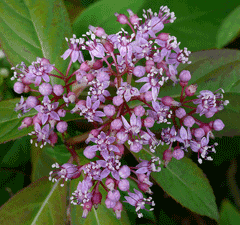 |
|
http://flickr.com/photos/13892958%40N07/ |
 |
| http://flickr.com/photos/13892958%40N07/ |
Translate this page:
Summary
Bloom Color: Blue. Form: Rounded, Spreading or horizontal.
Physical Characteristics

 Dichroa febrifuga is an evergreen Shrub growing to 2 m (6ft 7in) at a medium rate.
Dichroa febrifuga is an evergreen Shrub growing to 2 m (6ft 7in) at a medium rate.
See above for USDA hardiness. It is hardy to UK zone 9. It is in leaf all year, in flower from June to August, and the seeds ripen from August to October. The species is hermaphrodite (has both male and female organs).
Suitable for: light (sandy), medium (loamy) and heavy (clay) soils. Suitable pH: mildly acid, neutral and basic (mildly alkaline) soils and can grow in very acid soils.
It can grow in semi-shade (light woodland) or no shade. It prefers moist soil.
UK Hardiness Map
US Hardiness Map
Synonyms
Plant Habitats
Woodland Garden Dappled Shade; Shady Edge; South Wall. By. West Wall. By.
Edible Uses
References More on Edible Uses
Medicinal Uses
Plants For A Future can not take any responsibility for any adverse effects from the use of plants. Always seek advice from a professional before using a plant medicinally.
Antiperiodic Emetic Expectorant Febrifuge Malaria Purgative
This plant is commonly used in Chinese herbalism, where it is considered to be one of the 50 fundamental herbs[218]. The leaves are purgative[218]. They are used in the treatment of stomach cancer[218]. The juice of the leaves is used in Nepal to treat coughs, colds and bronchitis[272]. A decoction of the stem bark is used in the treatment of fevers[218]. a decoction of the leaves is used to treat malarial fever[272]. The root contains several alkaloids[283] and is emetic, expectorant, febrifuge and purgative[51, 61, 146, 147, 176, 218, 240, 272]. The juice of the root is used in Nepal to treat fevers and indigestion[272]. This plant is 26 times more powerful than quinine in the treatment of malaria but causes vomiting[176]. Substances in the plant are 100 times more powerful than quinine, but they are poisonous[218].
References More on Medicinal Uses
The Bookshop: Edible Plant Books
Our Latest books on Perennial Plants For Food Forests and Permaculture Gardens in paperback or digital formats.

Edible Tropical Plants
Food Forest Plants for Hotter Conditions: 250+ Plants For Tropical Food Forests & Permaculture Gardens.
More

Edible Temperate Plants
Plants for Your Food Forest: 500 Plants for Temperate Food Forests & Permaculture Gardens.
More

More Books
PFAF have eight books available in paperback and digital formats. Browse the shop for more information.
Shop Now
Other Uses
The wood is used as a fuel[272].
Special Uses
References More on Other Uses
Cultivation details
Landscape Uses:Erosion control, Ground cover, Massing, Rock garden. An easily grown plant, succeeding in an open loamy soil[1]. The flowers vary in colour according to the type of soil they grow in, the best blue colour is formed when plants are in very acid soils[260]. One report says that this plant is probably not hardy outdoors in Britain[11] whilst another says that some provenances tolerate temperatures down to about -5°c[260] and another report says that the forms in cultivation are only fully hardy in southern Cornwall[1]. This same report goes on to say that those forms probably do not belong to D. febrifuga in the strict sense[1]. This plant is cultivated in Russia as an anti-malarial herb[240]. Special Features:Not North American native, Attractive flowers or blooms.
References Carbon Farming Information and Carbon Sequestration Information
Temperature Converter
Type a value in the Celsius field to convert the value to Fahrenheit:
Fahrenheit:
The PFAF Bookshop
Plants For A Future have a number of books available in paperback and digital form. Book titles include Edible Plants, Edible Perennials, Edible Trees,Edible Shrubs, Woodland Gardening, and Temperate Food Forest Plants. Our new book is Food Forest Plants For Hotter Conditions (Tropical and Sub-Tropical).
Shop Now
Plant Propagation
Seed - we have no information on this species but suggest sowing the seed in a greenhouse in spring and only just covering it. Do not allow the compost to dry out. When they are large enough to handle, prick the seedlings out into individual pots and grow them on in the greenhouse for at least their first winter. Plant them out into their permanent positions in late spring or early summer, after the last expected frosts. Cuttings. No details are given, we suggest trying in August with almost ripe wood in a frame.
Other Names
If available other names are mentioned here
Native Range
TEMPERATE ASIA: China (Anhui Sheng, Fujian Sheng, Gansu Sheng, Guangdong Sheng, Guangxi Zhuangzu Zizhiqu, Guizhou Sheng, Hubei Sheng, Hunan Sheng, Jiangxi Sheng, Shaanxi Sheng, Sichuan Sheng, Xizang Zizhiqu), Taiwan TROPICAL ASIA: Bhutan, India (Sikkim), Nepal, Cambodia, Laos, Myanmar, Thailand, Vietnam, Malaysia
Weed Potential
Right plant wrong place. We are currently updating this section.
Please note that a plant may be invasive in one area but may not in your area so it's worth checking.
Conservation Status
IUCN Red List of Threatened Plants Status :

Growth: S = slow M = medium F = fast. Soil: L = light (sandy) M = medium H = heavy (clay). pH: A = acid N = neutral B = basic (alkaline). Shade: F = full shade S = semi-shade N = no shade. Moisture: D = dry M = Moist We = wet Wa = water.
Now available:
Food Forest Plants for Mediterranean Conditions
350+ Perennial Plants For Mediterranean and Drier Food Forests and Permaculture Gardens.
[Paperback and eBook]
This is the third in Plants For A Future's series of plant guides for food forests tailored to
specific climate zones. Following volumes on temperate and tropical ecosystems, this book focuses
on species suited to Mediterranean conditions—regions with hot, dry summers and cool, wet winters,
often facing the added challenge of climate change.
Read More
Expert comment
Author
Lour.
Botanical References
1151266
Links / References
For a list of references used on this page please go here
Readers comment